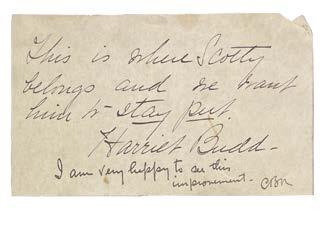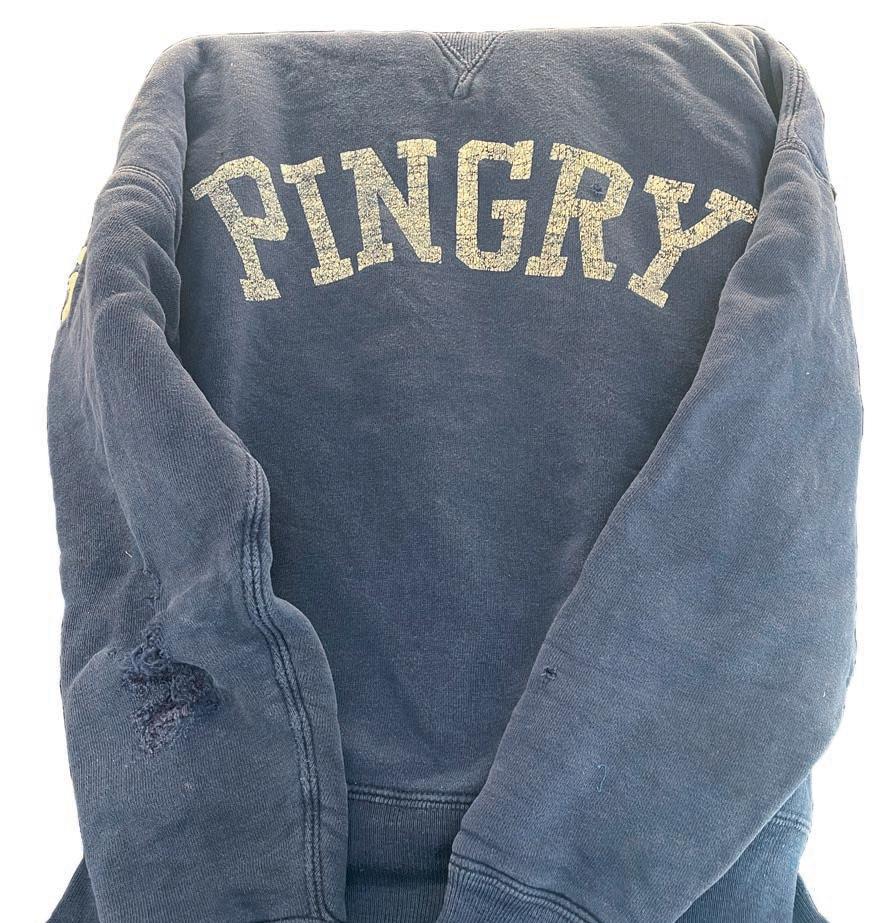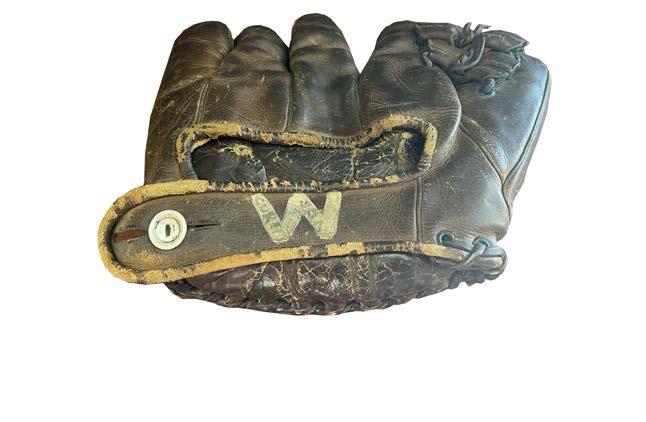
7 minute read
A Visit to the Archives
Within one month this summer, Pingry received memorabilia associated with two significant figures in School history: former Head of School Scotty Cunningham ’38, P ’78, ’80 (served as Head from 1970–1980) and former Athletic Director and coach Reese Williams P ’55 (worked at Pingry from 1920–1965).
The mementos from Mr. Cunningham’s years as a student and an administrator were donated by his daughter, Ann Cunningham Stachura ’78. Mr. Williams’ collection was donated by his granddaughter, Jody Curtis (daughter of Mr. Williams’ daughter, Anne Curtis). Mrs. Cunningham Stachura and Ms. Curtis share their memories with The Pingry Review.


Highlights of the Scotty Cunningham ’38, P ’78, ’80 memorabilia: pennants; track ribbons; news clips collected and organized by his wife and mother; drama programs; Pingry letters; and track medals.
Mrs. Cunningham Stachura donated her father’s report cards from Grade 1 through his post-graduate year “because there are handwritten notes to young Scotty from Harriet Budd—who the heck has seen a handwritten note from Harriet Budd?! C. B. Newton wrote several notes, too. In my Pingry brain, these are celebrities!”




Asked about her father’s love of running, Mrs. Cunningham Stachura says he excelled at sports—football, basketball, baseball, and track. “He loved being part of a team, and sportsmanship was really important to him.” The collection includes track and field medals from his high school career, covering Union County and State meets. Scotty Cunningham ’38 Leaves Pingry . . . and Returns Mrs. Cunningham Stachura relates this story: “He started at Pingry at age 5 and attended through 1929 when the Depression hit. He had to leave Pingry and went to public school in Elizabeth for a year. But he lived near Pingry and went to the Parker Road Campus in the afternoons to play with his friends on the fields. One day, a trustee was there, meeting with the Head of School [C. B. Newton], and they were watching the boys play. One of the boys got hurt, so my Dad tended to him—the trustee was impressed by his behavior, saying that Pingry wants to produce students like that, who selflessly help others. The Head of School told him that Scott Cunningham was a casualty of the Depression and was no longer at Pingry, so the trustee arranged for a scholarship for my Dad for the rest of his schooling at Pingry, through his post-graduate year. For college, thanks to his running and the exposure at some of the track meets, he was offered a full ride for athleticism at several schools, and he took the football scholarship at William & Mary.”
File Cabinets Were Really Organized That Way?
Mrs. Cunningham Stachura shares a Pingry memory that is certain to make a few eyes widen!
“When I was about 14, I wanted a job. My father arranged for me (an incoming freshman coming from Kent Place to Pingry as one of the first 100 girls!) to work that summer in the Alumni Office. The first thing I was asked to do was file the folders of the new graduates in a room lined with five-drawer metal filing cabinets. I was told that this would take a very long time. ‘Why,’ I wondered, ‘would it take a long time? Just put the Class of 1974 behind the Class of 1973, right? In alphabetical order, of course.’ Well . . . the alumni were all filed alphabetically . . . not by class. I was expected to move files backward to accommodate the new files. Alphabetically. With everyone since Dr. Pingry’s day. I suggested that we reorganize the cabinets by class . . . and alphabetically within each class . . . so that’s what I was allowed to do.

I spent all summer reorganizing those cabinets and going through the files . . . there were a few (!) misfiled items. It was, however, a joy for me. I lived in the C. B. Newton house in Hillside and had grown up on stories of Harriet Budd, Nelson Carr, and others. To go through those files and all of that history was magical and a truly wonderful first job. Reading about all of the people I had heard about brought them to life. Seeing the handwritten notes made it all real—notes from teachers and administrators, college recommendations . . . I love the written word, I love letters.”
A Visit to the Archives




Highlights of the Reese Williams P ’55 memorabilia: commemorative scroll from the 1950 Football Team; commemorative scroll recognizing his 25 years as Athletic Director; his vintage Pingry sweatshirt (Ms. Curtis notes that it is unusually heavy); his 1920s glove; the 1931 football trophy; and photos of Coach Williams leading gymnastics at the Lower School (Ms. Curtis notes that he loved gymnastics, bodybuilding, and acrobatics).



Facts About Reese Williams at Pingry
• As football coach, he never missed a game or practice in 35 years. • Although he coached football and baseball, he prioritized teaching boys and young men sportsmanship and fair play. (This is reflected in the “In Pingry History” column on this page.) • He believed players of all abilities should have field time. • He loved working at Pingry and felt lucky to have landed at the School early in his career and stayed until he retired. At one point, he was quoted as saying that he was glad he had “hitched his wagon to a star.” • His son, Roger ’55, played football with his father as coach, including as a member of the undefeated, Hall of Fame 1952 team. His daughter, Anne, went to Vail-Deane and remembers teaching swimming lessons one summer at the Pingry pool.
pingry.org: To learn more about Pingry’s Archives, visit the new Archives page under “Teaching & Learning” (pingry.org/teaching-learning/pingry-archives). Offerings include . . . • Collections (Admiral Halsey, Publications, Theater Programs, Athletics Hall of Fame, and more) • Displays and Exhibits (Pingry People Through the Years, Community Awards, Hillside
Campus, and more) • Pingry Flashes Back (monthly blog as a virtual visit to the Archives) • Guidance for donating to Pingry’s Archives
In Pingry History
10 YEARS AGO The Upper School Fall Play is On the Razzle, with the cast and crew working extra hard— and quickly—after Hurricane Sandy disrupts a week’s worth of rehearsals.
20 YEARS AGO The Veterans Day Assembly pays tribute to the Tuskegee Airmen, with two guest speakers: Lt. Col. Thomas E. Highsmith, Jr., who served as a Tuskegee Airman, and Leroy Gillead III, Esq., whose father served as one.
30 YEARS AGO Water Polo is introduced as a fall sport in the Middle and Upper Schools. Then–Swimming Coach Bill Reichle P ’00 initiates the program to help swimmers prepare for the winter season.
40 YEARS AGO Grades 7–12 participate in the “Walk for Henry” to benefit the Stifel Paralysis Research Foundation, launched after an automobile accident that paralyzed Henry G. Stifel III ’83.
50 YEARS AGO The “Thursday Afternoon Program” is established for students during their free time if they are not in Glee Club; the block of time features speakers, movies, demonstrations, and seminars.
60 YEARS AGO Economics is introduced as a voluntary course without credit, appealing to students who want to learn something for the “rewards of knowledge and understanding” (according to The Pingry Record).
70 YEARS AGO Robert Engisch ’47, in his second year at Cornell University Medical College, speaks to the Upper School about pre-medical education. (He would become a board-certified neurologist.)
80 YEARS AGO Reese Williams writes a column for The Pingry Record, “Every Boy Has Opportunity To Participate In Physical Development At Pingry.” In it, he describes physical education as “an absolute essential in the physical, mental and moral make-up of a boy” and concludes that “the greatest lesson . . . is the spirit of fair play and good sportsmanship.”
90 YEARS AGO C. B. Newton defines the purpose, make-up, and functions of Student Council. Purpose: to give the students practice in self-government and provide a body to reflect student opinion. Make-up: President of the Senior Class (who serves as President of the Council), two other seniors, two juniors, one sophomore, and one freshman. Functions: jurisdiction over matters involving the students outside of classrooms and study halls, and consider matters that affect students’ welfare and happiness.








